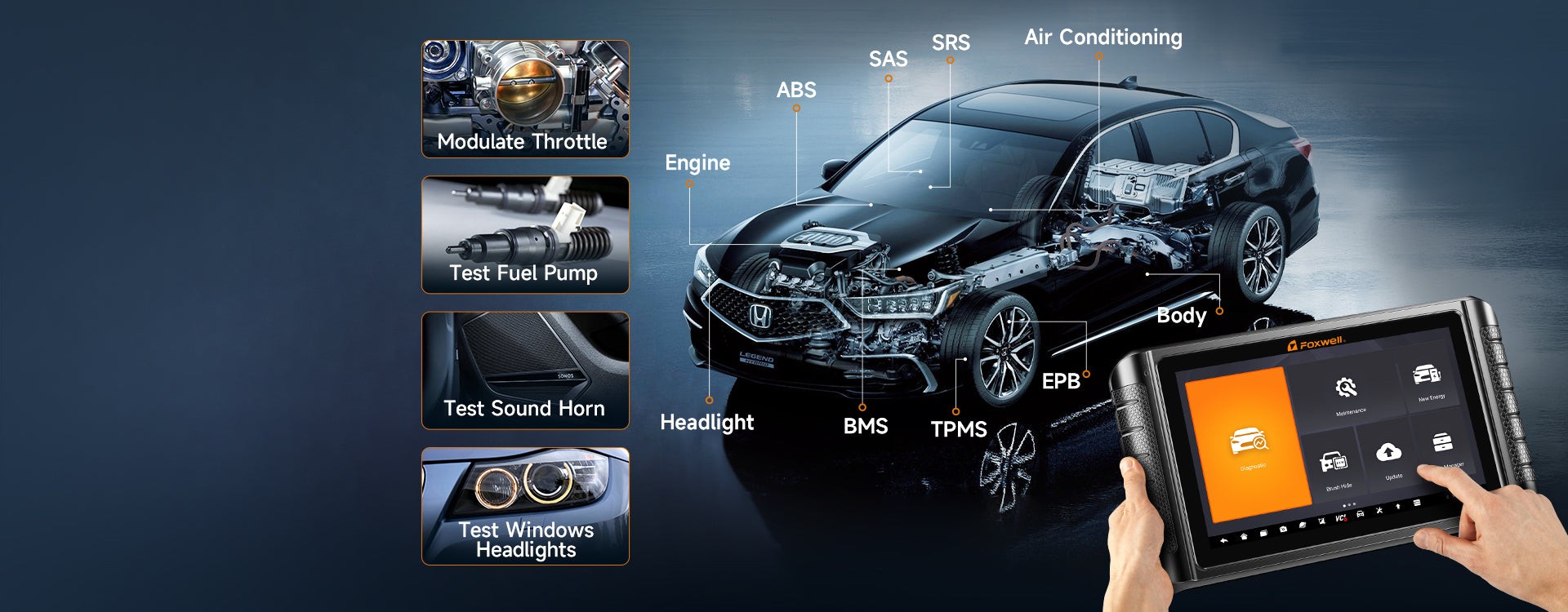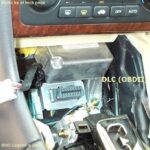So, Saturday morning rolls around, and you’re all set to tackle that pesky check engine light using your trusty Foxwell NT650 Elite OBD2 scanner. Excitement turns to frustration when, just as you’re about to get started, the scanner refuses to power on. It’s dead. Silence. Don’t panic! This common issue is often simpler to resolve than you might think. Let’s dive into some straightforward steps to diagnose and fix why your OBD2 scanner isn’t turning on, getting you back to diagnosing your car in no time.
Decoding Why Your OBD2 Scanner Is Silent
Alt text: Technician using a Foxwell OBD2 scanner to diagnose a car, highlighting all system diagnosis and bidirectional control features.
Before assuming the worst, let’s consider the common culprits behind an OBD2 scanner that won’t power up. Think of your scanner and your car’s OBD2 port as needing to have a clear line of communication. If that line is broken at any point, your scanner will remain stubbornly off.
Connection Conundrums
Just like a detective needs to be at the crime scene, your OBD2 scanner needs to properly connect to your car’s OBD2 port. These ports often play hide-and-seek, typically located under the dashboard on the driver’s side.
- Locating the OBD2 Port: First things first, are you sure you’ve found the OBD2 port? If you’re unsure of its exact location, your car’s owner’s manual is your best friend. It will pinpoint the port’s location, acting as your treasure map in this diagnostic adventure.
- Ensuring a Solid Connection: Think of plugging in your scanner like shaking hands – you need a firm, complete connection. Make sure the scanner is pushed in all the way into the OBD2 port. A loose or partial connection is like a weak handshake – ineffective and not very reassuring.
- Inspect for Damage: Time to put on your detective hat. Carefully examine both the OBD2 port in your car and the connector on your scanner for any signs of damage. Look for bent pins inside the port or on the scanner’s plug, or any loose sockets. Damage here can seriously disrupt communication and prevent your scanner from powering on.
Compatibility Concerns
Not all scanners are created equal, and sometimes, they simply don’t play nicely with every vehicle. It’s like trying to fit a square peg in a round hole.
- Vehicle Age and Model: If your car is a bit older, especially models manufactured between 1996 and 2004, OBD2 compatibility becomes a crucial point to verify. While the Foxwell NT650 Elite is designed for broad compatibility, it’s always wise to double-check if it’s the right match for your specific car make and model before assuming a malfunction.
- Scanner and Vehicle Harmony: Think of scanners as having preferences – some are more compatible with certain car brands or models than others. Before you assume your scanner is faulty, confirm it’s designed to work with your vehicle. Checking compatibility lists or manufacturer specifications is a smart move.
Power Predicaments
Your OBD2 scanner, like any electronic device, needs power to operate. No power, no party.
- Ignition Position Matters: Is your car’s ignition turned to the “ON” position? Many OBD2 scanners are designed to only power up when they detect that the car’s ignition is in the “ON” position. Simply having the key in the ignition isn’t always enough; ensure it’s turned to the correct position – usually just before you start the engine.
- Battery Health Check: A weak or low car battery can sometimes prevent enough power from reaching the OBD2 port and, consequently, your scanner. Make sure your car battery is in good health and fully charged. A weak battery could be the unseen culprit in your scanner’s silence.
Software and Firmware Foibles
Outdated software is like using an old map – it might not get you where you need to go, and it can definitely cause issues.
- Firmware Updates are Key: Check the manufacturer’s website, in this case, Foxwell for your NT650 Elite, to see if there are any available firmware updates for your scanner. Software updates often include bug fixes and improved compatibility, which could resolve power-on issues. Using the scanner’s website updater is usually a straightforward process.
- App Compatibility and Updates: If your OBD2 scanner uses a companion app on your smartphone or tablet, ensure both the app and the scanner’s software are up-to-date and compatible with each other. Outdated apps can sometimes cause communication problems that manifest as the scanner not turning on.
Vehicle Communication Protocol Problems
Cars, internally, communicate using different “languages” or protocols. Your scanner needs to speak the same language to work.
- Protocol Verification: Confirm that your OBD2 scanner is compatible with the communication protocols used by your vehicle. Common protocols include CAN, ISO9141, KWP2000, and J1850. The good news is that the Foxwell NT650 Elite is designed to support multiple protocols, making it a versatile tool. However, verifying compatibility is still a good step in troubleshooting.
Troubleshooting Tactics
Now, let’s get hands-on with troubleshooting why your OBD2 scanner remains stubbornly off. These user-friendly tactics should help you pinpoint the problem and hopefully get your scanner working again.
Re-examine Connections
Even if it seems obvious, double-checking the physical connection is always a smart first step. It’s surprising how often a simple connection issue is the root cause.
- Unplug and Reconnect: Try the simple yet effective method of unplugging your scanner from the OBD2 port completely. Wait for a second or two, and then firmly plug it back in, ensuring it’s snug and secure. Sometimes, simply reseating the connection can work wonders, like a digital reset for the connection.
- The Wiggle Test: With the scanner plugged in, gently wiggle it. If you notice any looseness or if the connection doesn’t feel solid, try adjusting it or inspect the port for any debris or obstructions that might be preventing a proper connection. Then, try restarting your vehicle and scanner again.
Vehicle Reboot
Just like your computer sometimes needs a reboot, so does your car’s electronics. It’s a surprisingly effective troubleshooting step.
- Complete Power Cycle: Turn your car off completely. This means turning off the ignition, removing the key (or pressing the start/stop button until everything is off), and then waiting for a full minute. This allows all of the car’s systems to fully power down and reset.
- Restart and Re-engage: After waiting a minute, turn your car’s ignition back to the “ON” position (not just accessory mode – you need power to the OBD2 system). Now, try turning on your OBD2 scanner again. Ensuring the ignition is correctly positioned is key for the scanner to receive power.
Test on Another Vehicle
If you have access to a second car, this step can quickly help you determine if the issue lies with your scanner or your car.
- Borrow a Friend’s Car (Briefly): If possible, ask a friend or family member if you can quickly test your scanner on their vehicle. This is a fast way to isolate whether the problem is with your scanner itself or something specific to your car’s OBD2 system.
- Compare the Outcome: If your scanner powers up and works perfectly in another car, then the problem likely resides within your own car’s OBD2 system or related components. If the scanner still refuses to turn on in another vehicle, then the scanner itself is likely the issue and may require repair or replacement.
Manuals are Your Magic Books
Don’t underestimate the power of manuals. They are included with cars and scanners for a reason – they contain valuable troubleshooting information.
- Consult Your Car’s Manual: Dig out your car’s owner’s manual and look for the section on OBD2 or diagnostics. It might contain specific troubleshooting steps or notes about your vehicle model’s quirks related to the OBD2 port or system.
- Review Your Scanner’s Manual: Similarly, check the manual that came with your Foxwell NT650 Elite scanner. There may be specific troubleshooting instructions, FAQs, or tips related to power issues or connectivity that you may have overlooked.
When to Call in the Professionals
If you’ve tried all the above steps and your OBD2 scanner still won’t turn on, it might be time to seek professional help.
- Expert Mechanic Assistance: Consult a qualified and trustworthy mechanic who specializes in automotive diagnostics and OBD2 systems. They have the expertise and equipment to diagnose more complex issues within your car’s OBD2 system that might be preventing your scanner from powering on.
- Detailed Explanation is Key: When you take your car to a mechanic, be sure to explain in detail everything you’ve experienced and all the troubleshooting steps you’ve already tried with your OBD2 scanner. Providing as much information as possible will help them diagnose the problem more efficiently and effectively.
Alt text: Foxwell OBD2 scanner performing a battery test, demonstrating its diagnostic capabilities beyond basic code reading.
In Conclusion
There you have it! These troubleshooting tips should equip you to tackle the frustrating situation of an OBD2 scanner that refuses to power on. By systematically going through these steps, you’ll likely pinpoint the cause and get back to diagnosing your car like a pro. Happy scanning, and safe driving!
Do you have any other tips or questions regarding OBD2 scanner issues? Share them in the comments below and join the conversation!
FAQs
Why isn’t my OBD2 scanner connecting to my car at all?
Ensure your car’s ignition is in the “ON” position, double-check the OBD2 port for any damage, and confirm that your vehicle is indeed OBD2 compliant (most cars from 1996 onwards are).
Could a blown fuse be the reason my OBD2 scanner isn’t powering up?
Yes, absolutely. A blown fuse in your car’s electrical system can definitely cut power to the OBD2 port, preventing your scanner from connecting or turning on. Check your car’s fuse box diagram (usually in your owner’s manual) and inspect the fuse related to the OBD2 port or auxiliary power. Replace any blown fuses with the correct amperage rating.
Does my OBD2 scanner need special software to work?
Some advanced OBD2 scanners, particularly those with more features, may require specific software for updates or for accessing certain functions. Always check the manufacturer’s instructions and website for software compatibility details and update procedures for your specific scanner model. For basic diagnostic functions, most scanners are plug-and-play, but software can enhance their capabilities and compatibility.

